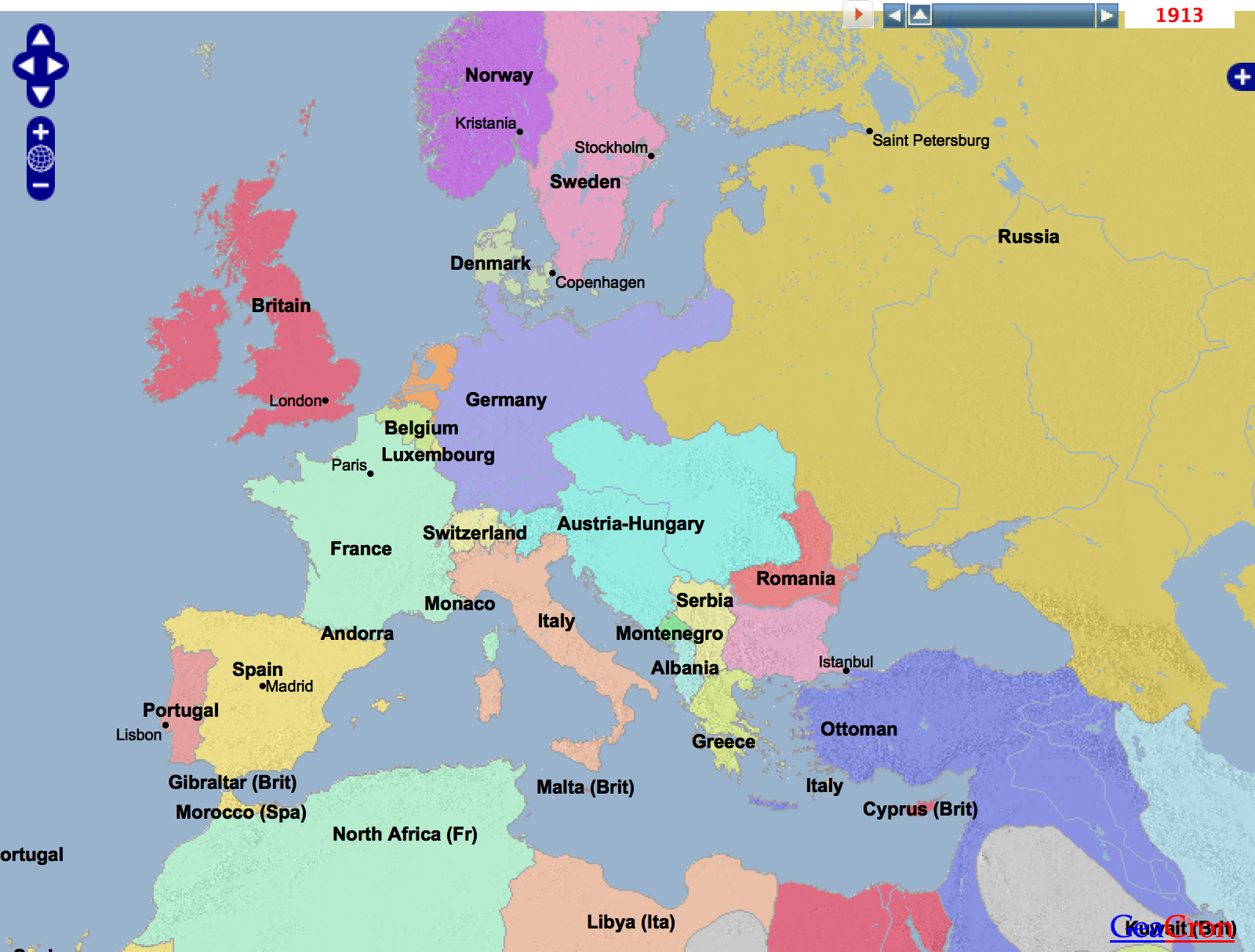World War I in the Spanish curriculum
The outbreak of World War I: causes and generators
Analysis of the reasons for the outbreak of an inevitable war (or not...)
World War I or the Great War broke out after the assassination of the archduke Franz Ferdinand, heir of the Austria-Hungarian throne, in June 114. Nevertheless the reasons for the conflict are rather more complex and go far beyond the assassination. What were the causes that unleashed this war? What does your textbook say on the subject? Was it an avoidable war or, sooner or later, would it break out? With these activities you'll be able to dive into the causes of this conflict and know the responsibility that historians from different countries give to each power, almost a century after an event which changed the European map.
Notice the changes which are produced in the European political map between 1913 and 1921. You can zoom and move the map to see the area with more detail.
Click here to interact with the map.
Tasks:
|
1 |
In the preceding map, note the evolution of the territories of the different nations involved in the conflict, between 1914 and 1918, and after the peace treaties, between 1919 and 1920. a. Which countries expand or lose territory and at who else's expense? Develop an annual index of countries (hint: note also Egypt, the Arabian Peninsula and The Middle East, up to the Caspian Sea) b. Which countries "appear" or "disappear"? Develop a year after year index. c. Which are the countries that expanded more between 1914 and 1918? What happens to them between 1919 and 1920? d. Which of the powers of that time lost more territory between 1914 and 1918? What happens to it between 1919 and 1920?
e. Analyzing your answers to the previous questions, could you deduce which have been the most important countries defeated in the Great War? |
|
2 |
Go through your textbook and find out the causes of the outbreak of the conflict. If you need it, surf the Internet for extra information. a. What is the fact unleashing the beginning of the war? Which countries spark it off? b. Why do other countries get involved in war? Which side does each one take? Which are the powers that make up the sides in dispute?
c. Do you believe that an attempt, by itself, could justify the outbreak of the war and the involvement of other countries? What causes unleashed the warlike offensive and the multinational participation? |
|
3 |
Compare these three explanations about the outbreak of war, coming from three Spanish textbooks (download texts here). Next answer the following questions a. Which of them do you think is more complete? Why?
b. According to these texts, was it Serbia who triggered the war or did Austria-Hungary use the attempt as a pretext to start the war? Why? c. Write an account about the outbreak of the war, as complete as possible, using all the information you can get from the three texts. |
Tasks:
Next some tasks are suggested to be done with the students in the classroom. Green colour is used to indicate some suggestions for their development, if considered necessary. You can use the activities suggested in the "student" version, adapting them conveniently.
|
1 |
Ask your students to observe the map in the presentation page. Explain them what the main countries involved in the conflict are and ask them to note how they are expanding their territories or, on the contrary, how they are losing them. Finally, invite them to note the differences between the 1914 map and the 1920 one. Next you may ask them to do the following activities: a. Ask your students to do tasks 1a y 1b in the student version. Compare together with them the differences between the map of Europe before the war, after the war, and the present map. What differences do they note? Which countries are the "generators of the war"? What are you based on to assert that? (suggestion: you can do this activity before and after explaining the subject , and notice the different views your students have of the map once they know the events) b. Analyzing the map from 1914 to 1920, is it possible to work out which countries have lost the war? How? (suggestion: you can do this activity before and after explaining the conflict) |
|
2 |
Ask the students to search their books for information about the causes of the outbreak of the conflict (Estimated time: 15 minutes) a. With the result of this research, organize a short debate on the reasons why it happens. (Suggestions for the debate: Is the attempt a strong reason to start the war? What interests did the different countries have to get involved in the conflict? Is there one only country responsible for the beginning of the war?)
b. Ask your students to compare these three explanations about the origin of the conflict, coming from other three Spanish textbooks for their learning level, with those in their textbook (download PDF with texts here). Invite them to note the differences among the different explanations (suggestion : you can use the questions in figure 3 in the student version or set out your own point of view) |
|
3 |
Arrange the students in groups of 2 or 3 people and, in a computer classroom, tell them to search for information about the causes of the outbreak of World War I, in order to:
a. Compare the information they find in different websites and make up a short summary of the results (estimated time : 30 minutes) |
Licensed under the Creative Commons Attribution-ShareAlike 2.5 License
